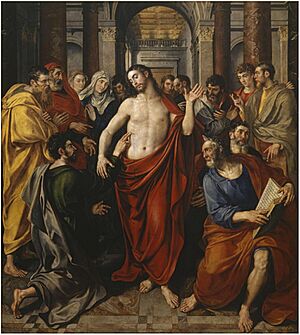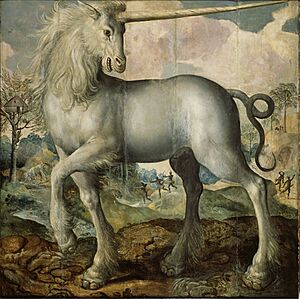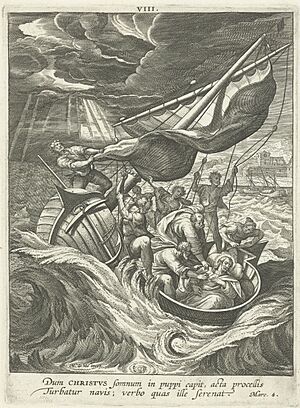Maerten de Vos facts for kids
Maerten de Vos (1532 – 4 December 1603) was a famous painter from Flanders (which is now part of Belgium). He is best known for his paintings that tell stories from history or myths, and also for his portraits. He was one of the most important history painters in the Spanish Netherlands after the career of another artist, Frans Floris, slowed down. This happened because of a time when many religious artworks were destroyed, known as the Beeldenstorm.
De Vos was also very good at drawing. He created many designs for printers in Antwerp. These designs were shared widely across Europe and even in Spanish colonies. This helped him become famous around the world. His drawings were also used as ideas for tapestries and stained glass windows.
Contents
Life of Maerten de Vos
Maerten de Vos was born in Antwerp. He was the youngest of four children. His father, Peter de Vos, was also a painter. Maerten and his brother, Pieter, first learned to paint from their father. Some art experts think he might have also trained with Frans Floris, a leading painter at the time, but there is no clear proof.
Travels to Italy
In the 1500s, it was common for artists from Flanders to travel to Italy to learn more about art. De Vos went to Italy between 1550 and 1558. He might have traveled with another famous painter, Pieter Brueghel the Elder. He probably visited cities like Rome, Florence, and Venice. De Vos's paintings show a strong influence from the bright colors used by artists in Venice. An Italian writer from the 1600s, Carlo Ridolfi, wrote that de Vos even worked in the studio of Tintoretto, a famous Venetian painter. This could explain why his work looks so Venetian.
Return to Antwerp and Challenges
When de Vos returned to Antwerp in 1558, he became a member of the Guild of Saint Luke. This was a special group for artists. He married Joanna le Boucq, and they had eight children. At this time, Frans Floris was the most important history painter in Flanders. He had a very large workshop, which made it hard for other artists to find work. Luckily, de Vos got some important jobs from a rich merchant in Antwerp named Gillis Hooftman in 1564.
The Beeldenstorm and New Opportunities
In the 1560s, a period of great destruction happened in Flanders, called the Beeldenstorm. This Dutch word means 'attack on the images'. During this time, many Catholic artworks and church decorations were destroyed by Protestant groups. Frans Floris, who was the top painter then, was deeply affected by seeing his art ruined. He almost stopped painting after 1566.
This sad event created a chance for younger artists to become important. Maerten de Vos became one of the most famous painters during this time.
Growing Fame and Leadership
In 1570, de Vos was asked to decorate a chapel in Germany. His fame grew, and in 1572, he became the leader (dean) of the Antwerp Guild of Saint Luke. De Vos had first joined the Lutheran faith, but he later became Catholic again after the Fall of Antwerp. His career really took off after this. He received many important jobs from religious groups and guilds in Antwerp. He painted large altarpieces for the Antwerp Cathedral and other churches.
De Vos was so well-known that in 1589, he and another artist, Ambrosius Francken I, were asked to judge a painting by Raphael Coxie. They also helped design the decorations for a special event in Antwerp in 1594, when the new governor arrived. De Vos also helped start the Guild of Romanists in 1572. This group brought together artists and educated people who had traveled to Rome. It was a good way for artists to meet people who might want to buy their art. To keep up with all the demand for his work, de Vos set up a very efficient workshop.
Maerten de Vos taught 11 students between 1564 and 1599. His two sons, Daniel and Maerten the Younger, also became painters, but their work is not very well known today.
He passed away in Antwerp on 4 December 1603 and was buried in the cathedral.
Maerten de Vos's Artworks
What He Painted
Maerten de Vos mostly painted religious scenes. He also painted some mythological stories (from ancient myths) and allegories (pictures that represent ideas). He was also a skilled portrait painter. In the 1580s, he created many designs for prints and book illustrations. His style started with Mannerism, which is a bit dramatic, but then became clearer and more detailed. This style fit well with the ideas of the Counter-Reformation, a movement within the Catholic Church.
His brother, Pieter de Vos, was also a painter. Some artworks that were once thought to be by Maerten de Vos might actually be by his brother or another artist.
His Paintings
After the Beeldenstorm in 1566, many artworks in churches were destroyed. De Vos became one of the artists who helped decorate these churches again with new altarpieces. Many of these, like St. Luke Painting the Virgin (1602), were ordered by important groups in Antwerp. This painting was made for the Guild of St. Luke's altar in the Antwerp Cathedral. Another famous work is the Marriage at Cana (1597), painted for the wine merchants' guild.
Maerten de Vos was not an artist who invented completely new styles. Instead, he learned from many different masters. His work was influenced by Italian painters like Veronese, Tintoretto, and Michelangelo. He also learned from Flemish painters who were influenced by Italian art, like Frans Floris.
His style was easy to recognize. His art often showed themes from the Counter-Reformation. While his style didn't change much over time, his later altarpieces reminded people of earlier Dutch masters. In his later years, his colors became softer and more blended.
Prints and Drawings
De Vos was a very busy designer. His many drawings were made into prints by famous engravers like the Sadeler brothers and the Wierix brothers. These prints helped spread his art far and wide.
De Vos also made designs for famous publishers in Antwerp. These included designs for religious books like the Breviarium Romanum. He also designed pictures for a series of 13 prints showing Christian martyrs. Other series he worked on included the five senses, the seven deadly sins, the Christian virtues, the 12 months, the four seasons, and the seven wonders of the world. He drew 78 pictures for an illustrated Bible published in 1585. This Bible helped make de Vos's illustrations popular all over Europe.
About 1600 prints were made from de Vos's designs. These were shared widely in Europe and its colonies, making him famous around the world. A print showing the biblical story of Christ sleeping during the storm, based on de Vos's design, might have inspired Rembrandt's famous painting The Storm on the Sea of Galilee. The print was part of a 12-part series published in Antwerp in 1583. Rembrandt's painting is similar in its layout and shows the boat tilting forward, just like in the print. The Dutch painter Simon de Vlieger was also inspired by this print for his own painting of the same subject.
De Vos's drawings are known for being lively and often cheerful. They often feature beautiful Italian-style landscapes in the background. Because he was so good and drew so much, his work sometimes followed a certain pattern.
See also
 In Spanish: Marten de Vos para niños
In Spanish: Marten de Vos para niños




